The Motorola Moto Z & Moto Z Force (Droid Editions) Review
by Matt Humrick on July 28, 2016 8:00 AM ESTBattery Life
Our battery life tests simulate a few common workloads while controlling as many variables as possible, including calibrating each display to 200 nits at 100% APL.
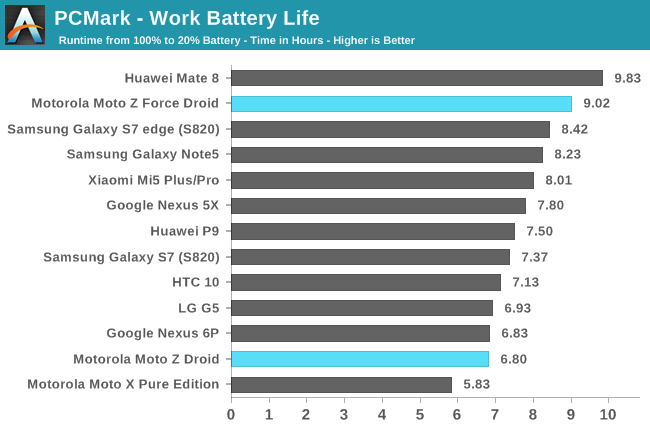
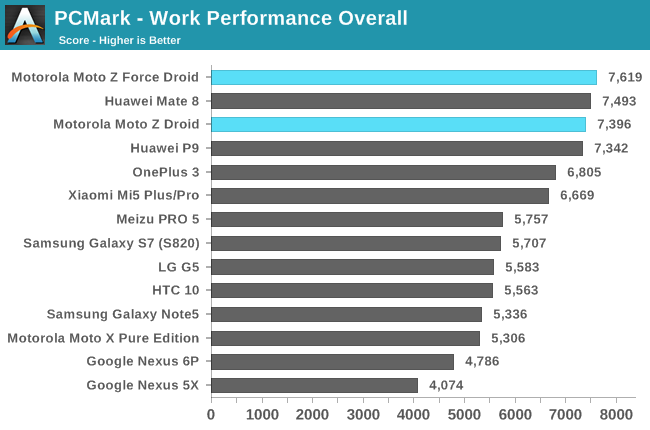
One of the primary differences between the Moto Z Droid and Moto Z Force Droid is battery size. At 2600mAh, the thinner Droid’s battery is undersized for a phone with a 5.5-inch display. The Moto Z Force Droid’s 3500mAh battery helps it last 33% (or just over 2 hours) longer in PCMark’s battery test, while the Galaxy S7 edge lasts 24% (or 1 hour and 37 minutes) longer. Even phones with smaller screens, such as the Huawei P9, HTC 10, and Galaxy S7, have larger batteries (3000mAh) than the Moto Z Droid, giving them marginally better battery life in this test. The LG G5’s battery is not much larger than the Moto Z Droid’s, so it’s no surprise they finish so close together. The Moto Z Force Droid manages to last 9 hours, longer than the other flagship phones we’ve tested except the Mate 8 and its 4000mAh battery.
After normalizing for battery size, both Moto Zs consistently last 7-10% longer in this test than other Snapdragon 820 phones. Without more specific testing it’s impossible to say if this small difference is the result of their higher-performing GPU driver allowing the Droids’ Adreno 530 to finish its work and get back to sleep more quickly, software settings, SoC binning, or something else.
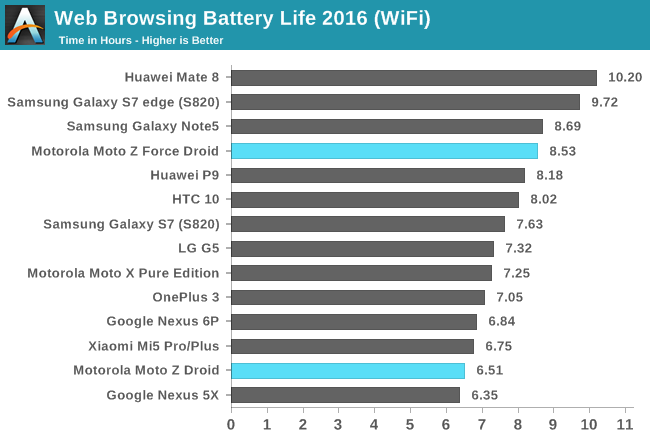
Our new browsing test makes better use of the CPU by pausing and then scrolling through each page after it’s loaded, but display power draw is still the limiting factor, with some additional power used by the wireless radio. In this scenario, the Moto Z Droids no longer show any significant advantage over their peers after normalizing for battery size. The Galaxy S7 edge’s average platform power is 11% less than the Moto Z Force Droid and the HTC 10 is 7% less than the Moto Z Droid, but the differences between the other Snapdragon 820 devices is no more than 5%. In general, battery life in this test closely follows the ratio of screen size to battery size, which puts the Moto Z Droid’s combination of a large screen and small battery at a disadvantage.
Attaching the 2220mAh Power Pack to the back of the Moto Z Force Droid extends battery life by 4.43 hours, or 52%, for a total runtime of 12.96 hours. The Power Pack adds about the same time to the thinner Moto Z, or 65%, for a total runtime of 10.72 hours. These tests were run using the “Efficiency Mode” setting that’s supposed to increase battery life by up to 20% by only charging the phone once it drops below 80% instead of keeping it topped off.

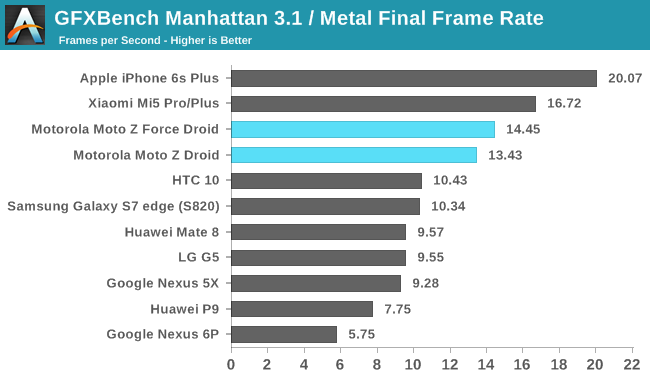
The larger battery in the Moto Z Force Droid is only good for an extra half hour of gaming in the GFXBench Manhattan 3.1 battery life test. Both Droids last more than 3 hours when pushing their GPUs hard, but they fall behind the Galaxy S7 edge and even the Nexus 6P and LG G5 in runtime; however, the Droids maintain a higher level of performance throughout the test, effectively doing more work than the other devices, which leads to the reduction in battery life. Because this test renders at the device’s native resolution, the 1080p displays in the iPhone 6s Plus and Xiaomi Mi5 Pro help them last longer and perform better than the Droids and other phones with QHD displays.
Flagship phones have enough peak performance to handle any game currently available, but they generate a lot of heat and are susceptible to thermal throttling—the process of reducing GPU frequency and performance to stay within an acceptable thermal envelope. While running GFXBench Manhattan ES 3.1, the HTC 10’s frame rate drops 35% because of throttling, eliminating its performance advantage over midrange GPUs that have better thermal stability. The Galaxy S7 edge (Snapdragon 820) also experiences a significant 33% drop in performance starting at the 8 minute mark. After dropping to a minimum of less than 8fps, performance stabilizes into a steady-state pattern after 31 minutes.
The Moto Z Droid has less thermal mass because it’s so thin, which means it should heat up more quickly than thicker phones. The graph above shows this is indeed the case, as the Moto Z Droid starts reducing GPU frequency after only 7 minutes. It reaches thermal equilibrium after 18 minutes and enters a period where it must constantly adjust frequency to stay within comfortable operating limits. Its overall performance drop of 28% is a little bit less than other Snapdragon 820 phones we’ve tested, however.
The thicker and heavier Moto Z Force Droid maintains peak performance for 12 minutes before gradually reducing GPU frequency. It takes 37 minutes to reach thermal equilibrium, with frame rates only 21% lower than peak values.
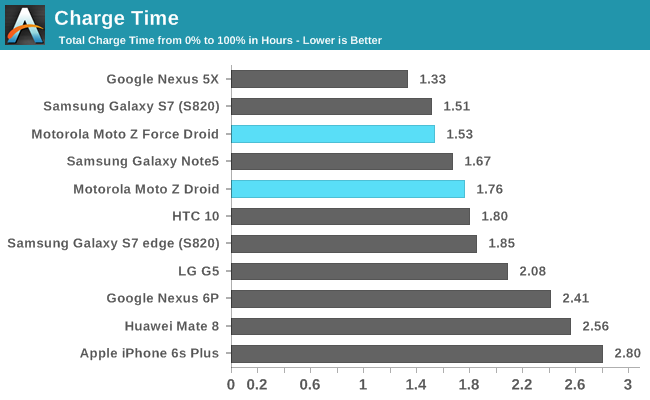
Both of the Moto Z Droids support Motorola’s TurboPower rapid charging technology. The small power bricks the phones ship with take up two slots on a standard power strip and have permanently attached cords rather than a separate cord that attaches via USB.
The Moto Z Force Droid’s charger is rated for 28.5W, which translates to a peak of 33W at the wall and 24.9W at the battery. Its peak charge cycle lasts 11 minutes and charges the battery 30% before gradually stepping down input power. The battery reaches 50% charge in 19 minutes and is fully charged in just 1.53 hours, a little faster than the Galaxy S7 edge and Galaxy Note5.
The Moto Z Droid uses a smaller 15W charger that delivers a peak of 11.1W at the battery. Its peak charge cycle lasts 43 minutes before it reduces input power. Its charge rate is slower than the Galaxy S7, especially when factoring in its larger 3000mAh battery, but its charge level still reaches 50% in 30 minutes and is fully charged in 1.76 hours.
Unlike some phones that reduce their charging rate when the display is turned on, both Moto Z Droids charge at peak levels whether the screen is on or off so long as the battery remains below its thermal threshold.



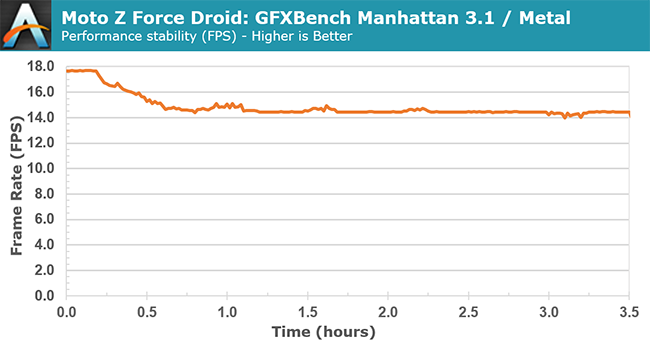
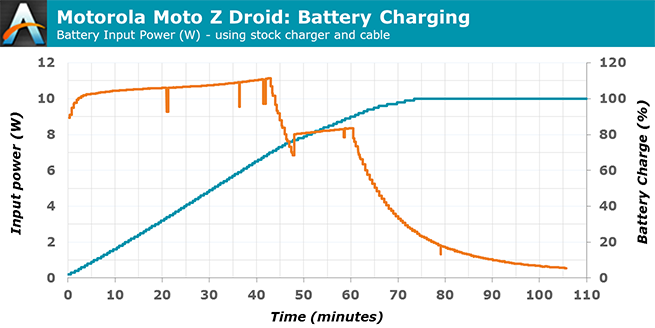
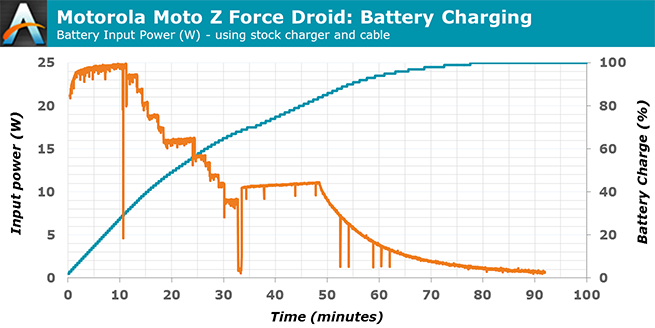








75 Comments
View All Comments
UtilityMax - Thursday, July 28, 2016 - link
What a non-issue. Why would you want to hook the headphones to your smartphone in a CAR. Geez. If you're driving the car, then that's not legal in many places and not safe.Daving - Thursday, July 28, 2016 - link
Its an issue if I'm sitting at work and want to charge and use headphones at the same time.phoenix_rizzen - Thursday, July 28, 2016 - link
What if you want to charge your phone while driving, and connect it to your stereo via the AUX input, for older decks that don't have Bluetooth support? :)erikiksaz - Friday, July 29, 2016 - link
Then buy a BT receiver and hook that up to the aux port. You'll now join the rest of us in year 2016 where cabling isn't a requirement.mortimerr - Sunday, July 31, 2016 - link
You are a fool buddy. No intelligent person would willfully want 3.55 removed for no reason, and have it replaced with Bluetooth. There are so many negatives compared to the positives. Not to mention the extra cost in switching all of your existing hardware over. Just plain foolish. I feel sorry for you.grant3 - Friday, July 29, 2016 - link
Yes, hands-free calling while driving is clearly "not safe" and instead people should be holding the phone to their ear.And absolutely no one has an AUX jack in their car to connect the phone to their car stereo. Because apparently listening to anything but the radio is "not legal in many places"
Thank you for the legal lesson.
evilpaul666 - Sunday, July 31, 2016 - link
Hands free driving with your phone while not paying attention to what's going on around you because you're paying attention to your fucking phone is no more safe than having something in your hand while you're not paying attention to what's going on around you.Having something in your hand or not in your hand isn't what makes people talking on phones shitty drivers. Not paying attention because of your "important phone call" (that could never occur and have no impact on your or anyone else's life) is.
lilmoe - Thursday, July 28, 2016 - link
iTardism at its best. Gimme more.osxandwindows - Thursday, July 28, 2016 - link
Coming to all smartphones near you. Hehehehe.grant3 - Friday, July 29, 2016 - link
"need to get over themselves" it seems you don't understand what this phrase acctually means.Someone who wants to use their existing headphones is "practical" not "conceited"
Wanting to charge your phone while simultaneously listening to music doesn't make someone a "luddite"
Perhaps you are blindly in love with the notion of USB headphones despite them providing no meaningful advantage over 3.5mm jack headphones